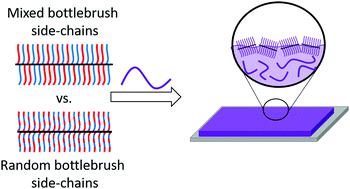当前位置:
X-MOL 学术
›
Soft Matter
›
论文详情
Our official English website, www.x-mol.net, welcomes your
feedback! (Note: you will need to create a separate account there.)
Understanding interfacial segregation in polymer blend films with random and mixed side chain bottlebrush copolymer additives
Soft Matter ( IF 2.9 ) Pub Date : 2021-09-08 , DOI: 10.1039/d1sm01146d Hao Mei 1 , Jyoti P Mahalik 2, 3 , Dongjoo Lee 1 , Travis S Laws 4 , Tanguy Terlier 5 , Gila E Stein 4 , Rajeev Kumar 3 , Rafael Verduzco 1, 6
Soft Matter ( IF 2.9 ) Pub Date : 2021-09-08 , DOI: 10.1039/d1sm01146d Hao Mei 1 , Jyoti P Mahalik 2, 3 , Dongjoo Lee 1 , Travis S Laws 4 , Tanguy Terlier 5 , Gila E Stein 4 , Rajeev Kumar 3 , Rafael Verduzco 1, 6
Affiliation

|
Bottlebrush polymers are complex macromolecules with tunable physical properties dependent on the chemistry and architecture of both the side chains and the backbone. Prior work has demonstrated that bottlebrush polymer additives can be used to control the interfacial properties of blends with linear polymers but has not specifically addressed the effects of bottlebrush side chain microstructures. Here, using a combination of experiments and self-consistent field theory (SCFT) simulations, we investigated the effects of side chain microstructures by comparing the segregation of bottlebrush additives having random copolymer side chains with bottlebrush additives having a mixture of two different homopolymer side chain chemistries. Specifically, we synthesized bottlebrush polymers with either poly(styrene-ran-methyl methacrylate) side chains or with a mixture of polystyrene (PS) and poly(methyl methacrylate) (PMMA) side chains. The bottlebrush additives were matched in terms of PS and PMMA compositions, and they were blended with linear PS or PMMA chains that ranged in length from shorter to longer than the bottlebrush side chains. Experiments revealed similar behaviors of the two types of bottlebrushes, with a slight preference for mixed side-chain bottlebrushes at the film surface. SCFT simulations were qualitatively consistent with experimental observations, predicting only slight differences in the segregation of bottlebrush additives driven by side chain microstructures. Specifically, these slight differences were driven by the chemistries of the bottlebrush polymer joints and side chain end-groups, which were entropically repelled and attracted to interfaces, respectively. Using SCFT, we also demonstrated that the interfacial behaviors were dominated by entropic effects with high molecular weight linear polymers, leading to enrichment of bottlebrush near interfaces. Surprisingly, the SCFT simulations showed that the chemistry of the joints connecting the bottlebrush backbones and side chains played a more significant role compared with the side chain end groups in affecting differences in surface excess of bottlebrushes with random and mixed side chains. This work provides new insights into the effects of side chain microstructure on segregation of bottlebrush polymer additives.
中文翻译:

了解具有随机和混合侧链瓶刷共聚物添加剂的聚合物共混薄膜中的界面分离
Bottlebrush 聚合物是复杂的大分子,具有可调节的物理特性,取决于侧链和主链的化学和结构。先前的工作表明,刷子聚合物添加剂可用于控制与线性聚合物共混物的界面特性,但尚未具体解决刷子侧链微结构的影响。在这里,我们结合实验和自洽场理论 (SCFT) 模拟,通过比较具有无规共聚物侧链的瓶刷添加剂与具有两种不同均聚物侧链的混合物的瓶刷添加剂的分离,研究了侧链微观结构的影响化学。具体来说,我们合成了带有聚(苯乙烯-ran-甲基丙烯酸甲酯)侧链或聚苯乙烯(PS)和聚(甲基丙烯酸甲酯)(PMMA)侧链的混合物。瓶刷添加剂在 PS 和 PMMA 组成方面匹配,它们与线性 PS 或 PMMA 链混合,长度范围从短到长于瓶刷侧链。实验揭示了两种类型的瓶刷的相似行为,在薄膜表面略微偏爱混合侧链瓶刷。SCFT 模拟与实验观察定性一致,预测由侧链微结构驱动的瓶刷添加剂的分离仅存在轻微差异。具体来说,这些细微的差异是由瓶刷聚合物接头和侧链端基的化学性质造成的,它们分别被熵排斥和吸引到界面上。使用 SCFT,我们还证明了界面行为受高分子量线性聚合物的熵效应支配,导致界面附近的瓶刷富集。令人惊讶的是,SCFT 模拟表明,与侧链端基相比,连接瓶刷骨架和侧链的接头的化学作用在影响具有随机和混合侧链的瓶刷表面过量差异方面发挥了更显着的作用。这项工作为侧链微观结构对瓶刷聚合物添加剂分离的影响提供了新的见解。我们还证明了界面行为受高分子量线性聚合物的熵效应支配,导致界面附近的瓶刷富集。令人惊讶的是,SCFT 模拟表明,与侧链端基相比,连接瓶刷骨架和侧链的接头的化学作用在影响具有随机和混合侧链的瓶刷表面过量差异方面发挥了更显着的作用。这项工作为侧链微观结构对瓶刷聚合物添加剂分离的影响提供了新的见解。我们还证明了界面行为受高分子量线性聚合物的熵效应支配,导致界面附近的瓶刷富集。令人惊讶的是,SCFT 模拟表明,与侧链端基相比,连接瓶刷骨架和侧链的接头的化学性质在影响具有随机和混合侧链的瓶刷表面过量差异方面发挥了更显着的作用。这项工作为侧链微观结构对瓶刷聚合物添加剂分离的影响提供了新的见解。SCFT 模拟表明,与侧链端基相比,连接瓶刷骨架和侧链的接头的化学性质在影响具有随机和混合侧链的瓶刷表面过量差异方面发挥了更显着的作用。这项工作为侧链微观结构对瓶刷聚合物添加剂分离的影响提供了新的见解。SCFT 模拟表明,与侧链端基相比,连接瓶刷骨架和侧链的接头的化学性质在影响具有随机和混合侧链的瓶刷表面过量差异方面发挥了更显着的作用。这项工作为侧链微观结构对瓶刷聚合物添加剂分离的影响提供了新的见解。
更新日期:2021-09-15
中文翻译:

了解具有随机和混合侧链瓶刷共聚物添加剂的聚合物共混薄膜中的界面分离
Bottlebrush 聚合物是复杂的大分子,具有可调节的物理特性,取决于侧链和主链的化学和结构。先前的工作表明,刷子聚合物添加剂可用于控制与线性聚合物共混物的界面特性,但尚未具体解决刷子侧链微结构的影响。在这里,我们结合实验和自洽场理论 (SCFT) 模拟,通过比较具有无规共聚物侧链的瓶刷添加剂与具有两种不同均聚物侧链的混合物的瓶刷添加剂的分离,研究了侧链微观结构的影响化学。具体来说,我们合成了带有聚(苯乙烯-ran-甲基丙烯酸甲酯)侧链或聚苯乙烯(PS)和聚(甲基丙烯酸甲酯)(PMMA)侧链的混合物。瓶刷添加剂在 PS 和 PMMA 组成方面匹配,它们与线性 PS 或 PMMA 链混合,长度范围从短到长于瓶刷侧链。实验揭示了两种类型的瓶刷的相似行为,在薄膜表面略微偏爱混合侧链瓶刷。SCFT 模拟与实验观察定性一致,预测由侧链微结构驱动的瓶刷添加剂的分离仅存在轻微差异。具体来说,这些细微的差异是由瓶刷聚合物接头和侧链端基的化学性质造成的,它们分别被熵排斥和吸引到界面上。使用 SCFT,我们还证明了界面行为受高分子量线性聚合物的熵效应支配,导致界面附近的瓶刷富集。令人惊讶的是,SCFT 模拟表明,与侧链端基相比,连接瓶刷骨架和侧链的接头的化学作用在影响具有随机和混合侧链的瓶刷表面过量差异方面发挥了更显着的作用。这项工作为侧链微观结构对瓶刷聚合物添加剂分离的影响提供了新的见解。我们还证明了界面行为受高分子量线性聚合物的熵效应支配,导致界面附近的瓶刷富集。令人惊讶的是,SCFT 模拟表明,与侧链端基相比,连接瓶刷骨架和侧链的接头的化学作用在影响具有随机和混合侧链的瓶刷表面过量差异方面发挥了更显着的作用。这项工作为侧链微观结构对瓶刷聚合物添加剂分离的影响提供了新的见解。我们还证明了界面行为受高分子量线性聚合物的熵效应支配,导致界面附近的瓶刷富集。令人惊讶的是,SCFT 模拟表明,与侧链端基相比,连接瓶刷骨架和侧链的接头的化学性质在影响具有随机和混合侧链的瓶刷表面过量差异方面发挥了更显着的作用。这项工作为侧链微观结构对瓶刷聚合物添加剂分离的影响提供了新的见解。SCFT 模拟表明,与侧链端基相比,连接瓶刷骨架和侧链的接头的化学性质在影响具有随机和混合侧链的瓶刷表面过量差异方面发挥了更显着的作用。这项工作为侧链微观结构对瓶刷聚合物添加剂分离的影响提供了新的见解。SCFT 模拟表明,与侧链端基相比,连接瓶刷骨架和侧链的接头的化学性质在影响具有随机和混合侧链的瓶刷表面过量差异方面发挥了更显着的作用。这项工作为侧链微观结构对瓶刷聚合物添加剂分离的影响提供了新的见解。











































 京公网安备 11010802027423号
京公网安备 11010802027423号